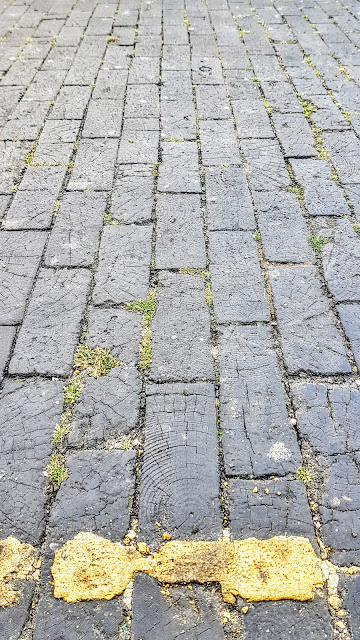 |
| Wooden detail on the road. |
"London's streets are paved with gold." - Uh, no they are not.
London's streets have never been paved with gold, obviously. They have, however, been paved in concrete, tarmac, cobbles, cork and wooden blocks, throughout the years. And, depending on the area of the city, a different type of wood was used: Australian Jarrah a hardwood was used in the 'posh' areas, while Swedish a yellow deal softwood was used on the main thoroughfares.
Although the idea of using wood had been around for years, it wasn't until 1839 that wooden blocks were first trialled on the streets of London, outside the Old Bailey.
 |
| Chequer Street. |
Then, in 1843, a meeting was brought to discuss the discontinuation of the use of wood in favour of granite cobbles (setts). Wood had proved to be problematic and it was found that the blocks would need to be covered in pitch and sanded. Also, accidents were occurring where roads went from one type of surface to another. The wooden blocks becoming slippery in wet weather.
Still, as the the roads were actually managed by local parishes and not central government, parishes preferred the wooden blocks which were less expensive than granite setts.
 |
| Chequer Street. |
In 1873 a 6 month experiment was conducted by the City of London Police on which surface was safer and had the better performance. Asphalt or wood.
The results showed that horses travelled further over wooden block paving, And if they stumbled in wet weather there were fewer injuries.
Some of the drawbacks of wooden paving blocks was that they absorbed whatever fell on them, like urine. On a hot day the smell from the roads was almost unbearable. And as more carts and horses compressed the wood, the blocks have up the absorbed fluids, spraying them up at passersby and covering the walls and windows of buildings.
Now, it may seem that this was so long ago as to be unworthy of note, but Regent Street was completely relaid with wooden blocks in 1930 and the surface of Chelsea Bridge was laid with wooden blocks, when it opened in 1937.
 |
| Timber details. |
 |
| A patch of wooden paving on Belvedere Road. |
So, next time you are in London and are about to cross a road, step on a manhole cover or take a shortcut through an alleyway, look at the floor and see if you can find some wooden paving blocks.
 |
| Detail on one of the blocks in Belvedere Road. |
No comments:
Post a Comment